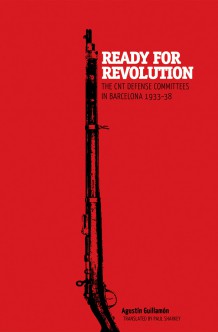Reviewer: Wouter van Dijk
Ready for Revolution. The CNT Defense Committees in Barcelona 1933-38, Agustín Guillamón
AK Press, Oakland, Edinburgh, Baltimore 2014
ISBN: 978-1-84935-142-3
Paperback, with illustrations in black and white, appendices, bibliography, glossary and index
261 pages
$14,95 / €17,99
Prepared for revolution
The CNT (Confederación Nacional del Trabajo – National Congress of Workers) anarchist union has been much studied throughout the years, by scholars focusing on the Spanish Civil War. However, comparatively little attention has been given to the grassroots organization of the movement which enabled the anarchists to deal so successfully with the armed rebellion of July 1936 in many places across Spain. Historian Agustín Guillamón, author of The Friends of Durruti Group 1937-1939 (2001), sets out to reveal how exactly the anarchist militiamen were able to respond so adequately in the chaotic days after rebellion broke out. Furthermore, he investigates their role in the Republican camp when the failed coup turned into civil war
The author describes the birth and evolution of the so-called anarchist defense committees. These groups played a decisive role in quelling the military rising at an early stage in July 1936 in many cities and villages around Spain. In his book Guillamón centers chiefly on Barcelona, perhaps the most revolutionary city in the country. He narrates how the defense committees were formed in 1934 from being primarily organized assault groups into sophisticated cadres that were busy with intelligence gathering, supplies, and military and logistical planning, all in order to be able to launch the inevitable revolution once the opportunity would present itself. This move was in line with the general shift in the CNT from the dogmatic idea of ‘spontaneous revolution of the masses’ that because it was massive and spontaneous would automatically bring victory, to a more realistic vision of the future in which protracted civil war was foreseen and which therefore needed careful preparation and planning.
After narrating the course of the military rising in Barcelona and its defeat at the hands of the loyal forces and workers, among whom the anarchists numbered many, Guillamón explains the part the defense committees played in the aftermath of the failed coup. They turned into militias with great speed, and almost without an adjustment had to be made to them, thanks to their pre-war organizational structure. The committees now took a lead in administrative services, such as issuing vouchers, food stamps, passes of safe conduct and the establishment of cooperatives. Besides that, they supplied and maintained hospitals, seized food, furnishings and buildings and funded schools. Most widely known however, is their service on the front as militia columns during the early stages of the war.
Soon a power struggle ensued between the revolutionary-backed CAMC (Central Antifascist Militias Committee) through which the militias were united in a central body, and Catalonia’s government, the Generalidad. The government could count on the support of Catalonia’s communist party PSUC (Partido Socialista Unificado de Cataluña) as the conflict grew larger. The Generalidad came out as the winner. After the May Events of 1937 the anarchist control patrols disappeared, leaving only PSUC-Stalinist secret prisons in use. In the meantime state repression from the central government expanded, eventually leaving the Generalidad powerless also.
Already in October 1936 the CAMC was formally abolished and its powers were transferred to the Generalidad. At the end of 1936 and the beginning of 1937 the militarization of the people’s milita’s took off with speed, as the need to form a united anti-fascist front with a proper army triumphed over the resistance to militarization, which was high among the CNT rank and file. It was also because of this, that the revolutionary ward defense committees eventually had to yield to the will of the upper echelons of the CNT and their intention of forming a unified anti-fascist bloc, thus leaving the defense committees essentially powerless as armed subordinates of the trade unions. The speedily built-up regular army, which contained reformed Assault Guards and Civil Guard troops, would hold the State’s monopoly to violence. At that point in December 1936 already, the revolution was effectively brought to a halt.
Guillamón then continues with the clash between the PSUC’s apparatsjik Gomorera and the CNT’s defense and supplies committees. Even with the supplies committees doing an excellent job in supplying the city of Barcelona, Gomorera’s only aim with their dissolvement was stripping the CNT anarchists of power in order to shift this power to the Generalidad. The Catalan government in the meantime was coming more and more under Stalinist influence because of Republican Spain’s dependence on the Soviet Union for military supplies.
In the author’s next treatment of the local Barcelona plenum in which the defense committees agreed to withdraw anarchist support from the government, one can see the meticulous research he has carried out to reconstruct the structure of the committees and how their decision-making took place. Guillamón relies a lot on meeting records, which in itself provide a rich ground for study. However, in following exactly the proceedings of those assemblies with the singling-out of every individual and what he has to say or thinks, these passages turn into somewhat dry reading. This is a bit regrettable, especially since Guillamón himself is a vivid writer.
Then when nearing the end of his book and also the end of the defense committees, Guillamón states that the widespread and fast barricading of Barcelona following the Assault Guards’ attack on the Telephone Exchange on May 3rd was the result of the carefully planned preparations of the defense committees. Not so spontaneous at all and certainly not the sudden popular backlash of the working classes, as popular myth wants us to believe.
Although the May Events proved to be a political defeat for the revolutionaries, as became clear with the banning of the anti-Stalinist Marxist party POUM and the arrest of its leaders, the power of the Barcelona’s defense committees remained intact. Eventually, between June and September 1937 they were disbanded by the forces of public order, some anarchist-held posts stormed one after the other. The committees then went undercover again, just as in the period prior to July 1936.
It has to be said that Guillamón with this book fills a void in the general knowledge on these groups that were so important on the Republican side in especially the beginning of the Spanish Civil War. At times, the book can be somewhat difficult to read but the wealth of information it contains make up for that without a doubt. Guillamón is an expert on the subject and that shows. The extensive glossary, additional appendices and rare photographs add to the book’s value. It sure is a recommended read for those interested in the anarchist experience during the Spanish Civil War.
Wouter van Dijk
